The Size Relationship of Parts to a Whole and to One Another in Art
We have all seen paintings that announced perfect in course and shape, everything is in proportion; the figures are in relation to each other and their surroundings, as well as their torso parts, are in relation to their bodies. When there is proportion in art, in that location is a harmony or unity of the whole, but conversely, when things appear out of proportion a painting seems strange. In this article, we volition discuss what is proportion in art and provide several accompanying examples.
Tabular array of Contents
- one What Is Proportion in Fine art?
- 1.1 The Difference Between Scale and Proportion in Art
- 2 The Types of Proportion in Art
- 2.ane Standard Proportion
- 2.two Altered Proportion
- two.3 Hierarchical Proportion
- 2.4 Out of Proportion
- iii Summary of Proportion in Art
- 4 Principles of Art – Farther Readings
- 5 Oftentimes Asked Questions
- 5.1 What Does Proportion Mean in Art?
- five.two What Are the Types of Proportion in Art?
- 5.3 What Is the Deviation Between Scale and Proportion in Art?
What Is Proportion in Art?
If nosotros look at the word "proportion", according to the dictionary, information technology ways a "harmonious relation of parts to each other or to the whole" and "proper or equal share". What this definition tells u.s.a. is that proportion works in ratios, where i part is in relation to the other.
So, what does proportion hateful in fine art?
To answer this question, nosotros would explore how different parts in a visual limerick share "proper" size, so to say, with each other to create a "harmonious" human relationship betwixt them and ultimately a harmonious visual limerick.
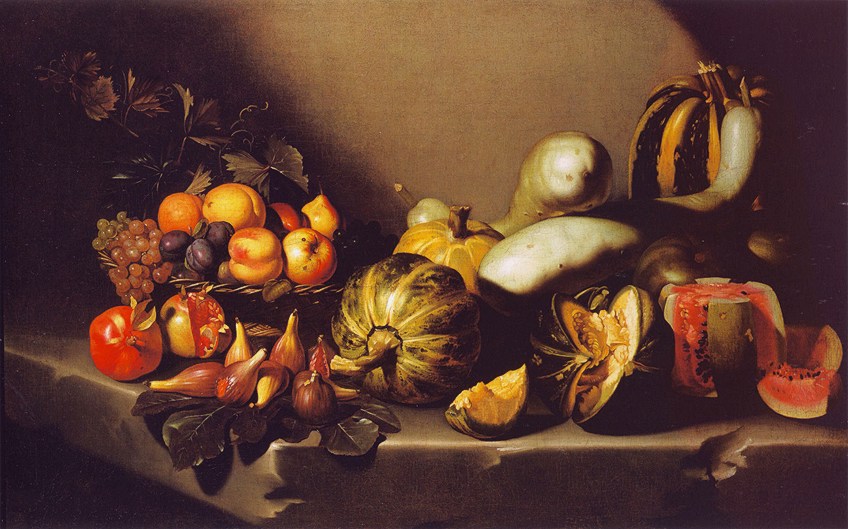 Still Life with Fruit (c. 1603) by Caravaggio;Caravaggio, Public domain, via Wikimedia Commons
Still Life with Fruit (c. 1603) by Caravaggio;Caravaggio, Public domain, via Wikimedia Commons
All the same, sometimes the unlike parts in a visual composition do non share the "proper" size between one some other and it appears out of proportion. In art, this tin either be intentional or as a lack of skill or training.
Proportion in art is one of the principles of art, of which at that place are several, namely, balance, unity, harmony, variety, rhythm, movement, repetition/pattern, scale, and proportion. The principles of fine art are used as guidelines with the elements of art, which make a visual composition. These are colour, value, shape, form, line, texture, and space.
The Difference Between Scale and Proportion in Fine art
Yous may have noticed that calibration is also amongst the principles of art; scale and proportion in art tin crusade confusion if it is not understood properly. It is important to remember the differences between the ii when creating artwork or analyzing an artwork.
Additionally, scale and proportion in art also work together.
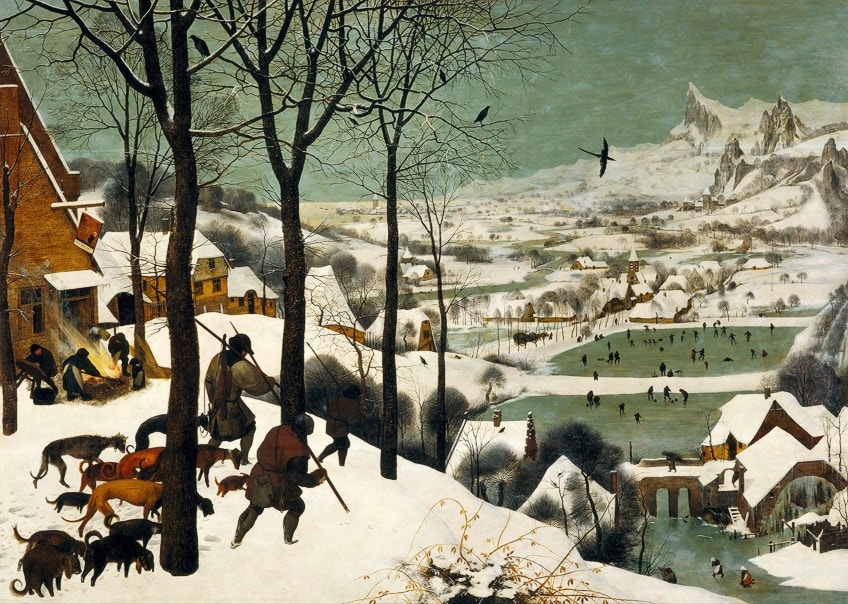 The Hunters in the Snow (1565) by Pieter Brueghel the Elder;Pieter Brueghel the Elder, Public domain, via Wikimedia Commons
The Hunters in the Snow (1565) by Pieter Brueghel the Elder;Pieter Brueghel the Elder, Public domain, via Wikimedia Commons
We already take a basic understanding of what proportion means, which is the relationship betwixt the size of parts inside a composition, specifically in terms of their dimensions; these parts tin exist anything from an object to a person's body parts or facial features.
Calibration refers to the size of objects and their relationship with each other in a composition.
Nosotros can think of proportion equally zooming in on or focusing more than on the intricacies between the relationship of the sizes of parts in a visual composition, and calibration provides a broader indication of the relationship of size between the parts when they appear as their whole.
 Fukagawa Susaki and Jumantsubo (1857) by Utagawa Hiroshige, from the series One Hundred Famous Views of Edo, no. 107, part 4: Winter;Utagawa Hiroshige, Public domain, via Wikimedia Commons
Fukagawa Susaki and Jumantsubo (1857) by Utagawa Hiroshige, from the series One Hundred Famous Views of Edo, no. 107, part 4: Winter;Utagawa Hiroshige, Public domain, via Wikimedia Commons
The Types of Proportion in Art
In that location are several types of proportion in art, namely, altered, hierarchical, out of proportion, and standard proportion. Below we explain each 1 with accompanying examples.
Standard Proportion
Standard proportion in art means that accurate or correct proportions are utilized for the subject affair. This applies to facial and body features every bit well every bit the full general congruency of proportion between parts in the art limerick that would suggest normal proportion.
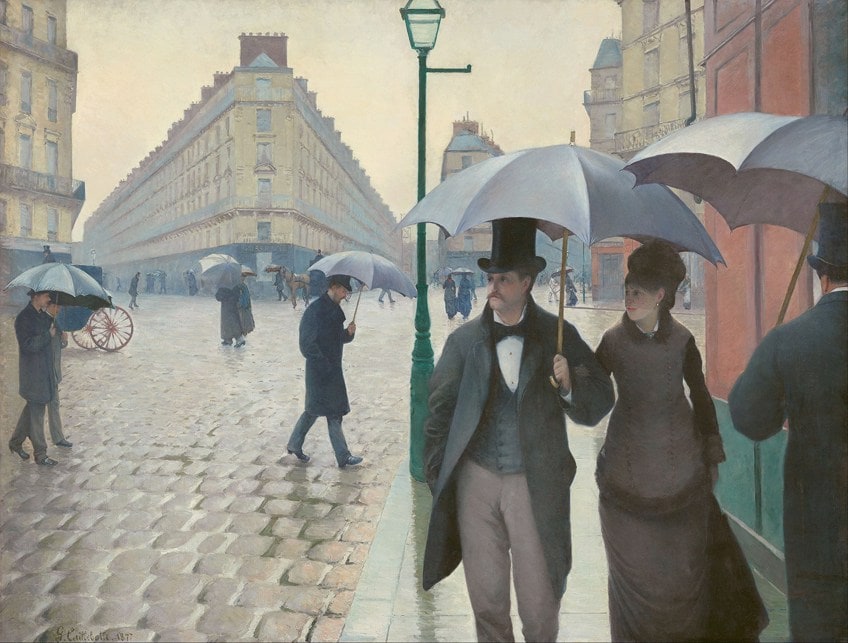 Paris Street, Rainy Day (1877) by Gustave Caillebotte;Gustave Caillebotte, Public domain, via Wikimedia Commons
Paris Street, Rainy Day (1877) by Gustave Caillebotte;Gustave Caillebotte, Public domain, via Wikimedia Commons
Nonetheless, co-ordinate to some art sources, it is important to note the questions effectually this in terms of standardizing facial and actual features, which would be an incommunicable chore as no body would mensurate the aforementioned.
We will find these attempts from Renaissance artists in detail, who studied human being anatomy, like Leonardo da Vinci or Michelangelo.
One standard proportion in fine art example includes the famous marble sculpture past Michelangelo titled David (1501-1504). Here, nosotros see a 17-anxiety sculpture of the Biblical figure David, however, regardless of his big calibration, he is in seemingly perfect proportion.
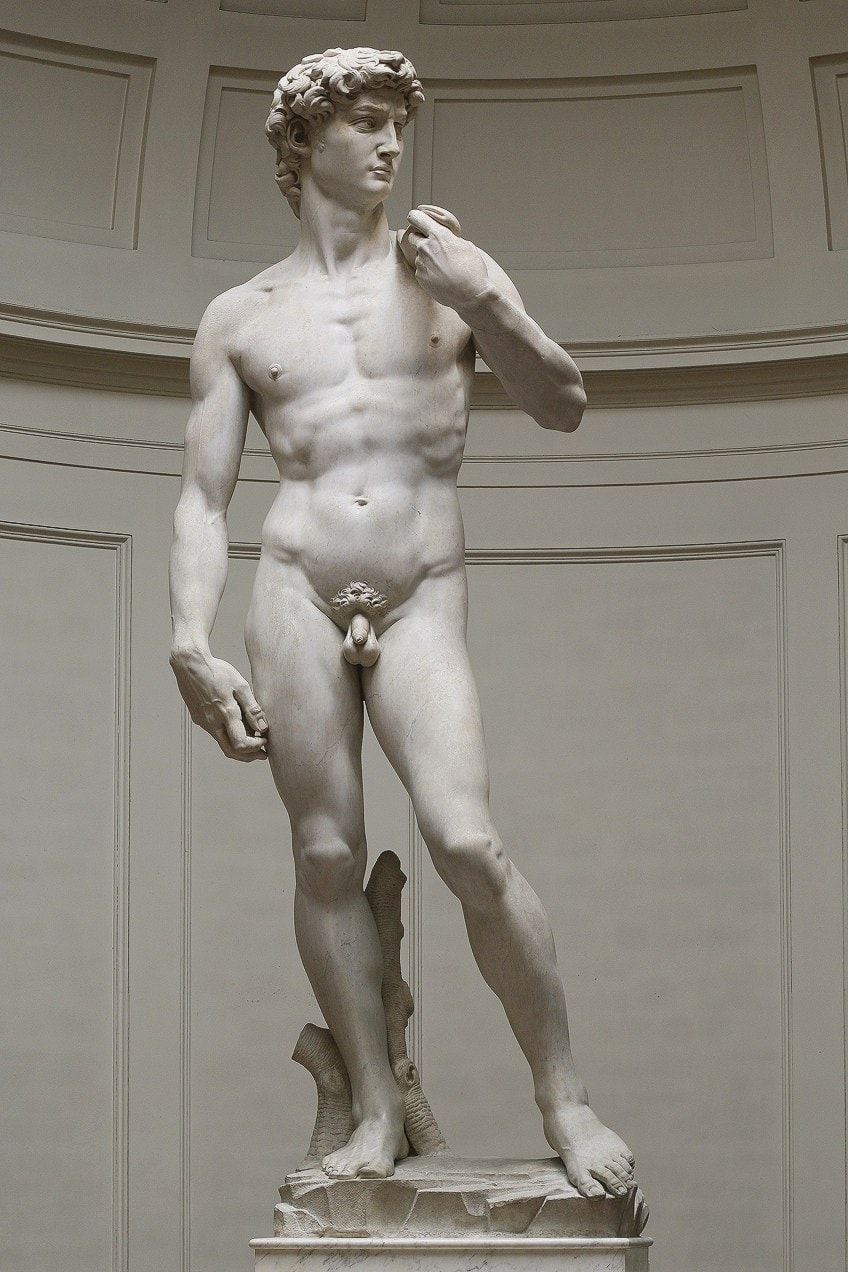 David (1501-1504) by Michelangelo, Florence, Galleria dell'Accademia;Jörg Bittner Unna, CC BY three.0, via Wikimedia Commons
David (1501-1504) by Michelangelo, Florence, Galleria dell'Accademia;Jörg Bittner Unna, CC BY three.0, via Wikimedia Commons
Altered Proportion
Altered proportion in art refers to an artwork where the proportion has been changed, distorted, or contradistinct for specific reasons; this is as well called "exaggerated" proportion by some. This type of proportion is utilized to tell a story, have a specific pregnant or message, or emphasize certain aspects to create an effect.
Altered proportion can come in all dissimilar shapes and sizes.
Some of the altered proportion in art examples include those from Cubist Pablo Picasso and his Mother and Kid (1921). Here, we see the exaggerated features in the female parent's figure; not merely are her arms quite large and her head smaller, but her facial features have an angularity.
Some describe this painting every bit having a "solidity" and "sculptural" quality, which emphasizes the female parent's role as a rubber and stable figure for the child. This besides ties in with the altered proportion of the female figure throughout art history, where female person body parts are exaggerated to emphasize the idea of fertility or motherhood. A famous example of this is the Venus of Willendorf (c. 25,000 BCE) limestone figurine.
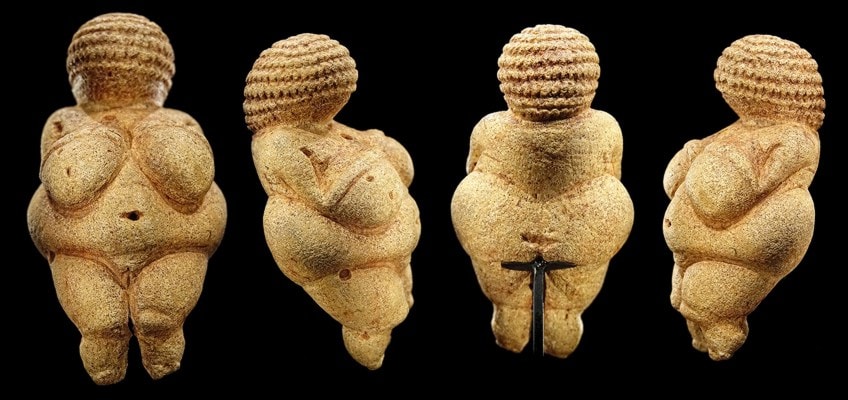 Venus of Willendorf figurine (c. 25,000 BCE), seen from all four sides; Bjørn Christian Tørrissen, CC BY-SA 4.0, via Wikimedia Commons
Venus of Willendorf figurine (c. 25,000 BCE), seen from all four sides; Bjørn Christian Tørrissen, CC BY-SA 4.0, via Wikimedia Commons
Hierarchical Proportion
Hierarchical proportion in art focuses on the importance of the subject matter, in other words, the hierarchy of figures in a composition to denote their status or level of ability or importance in a monarchy or social structure.
This is common in art from ancient cultures like Egypt, Sumer, Bharat, and others.
A hierarchical proportion in art case includes the Egyptian Palette of King Narmer (c. 3000-2920 BCE), which depicts the larger-sized effigy of the pharaoh in the heart, surrounded past smaller objects and figures.
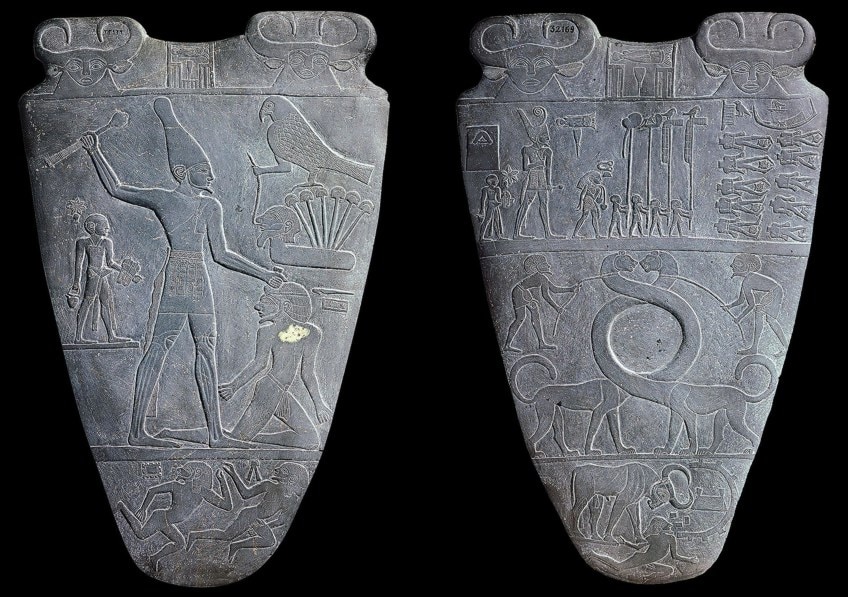 Both sides of the Narmer Palette (c. 3100 BC), Egyptian Museum, Cairo;Unknown, perhaps more i, Public domain, via Wikimedia Eatables
Both sides of the Narmer Palette (c. 3100 BC), Egyptian Museum, Cairo;Unknown, perhaps more i, Public domain, via Wikimedia Eatables
Another example, likewise Egyptian, includes Nebamun fowling in the marshes (c. 1350), which depicts the effigy of Nebamun standing on a boat with his wife and girl, who are depicted as smaller figures. This is from the Nebamun Tomb-chapel, which depicts the expressionless figure in the afterlife every bit happy and vibrant. His larger figure presides over the composition emphasizing his stature.
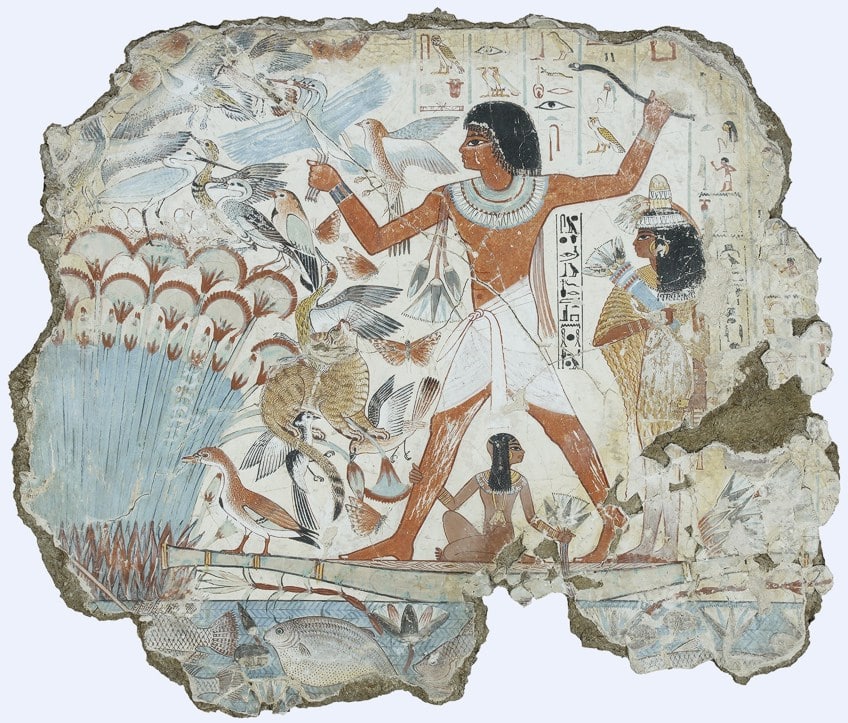 Nebamun fowling in the marshes (c. 1350); British Museum, Public domain, via Wikimedia Eatables
Nebamun fowling in the marshes (c. 1350); British Museum, Public domain, via Wikimedia Eatables
Out of Proportion
Out of proportion in art simply refers to the subject matter, exist it figures or objects, that are non in proper proportional relation to one another. For instance, a figure's caput could be the size of an apple in relation to the balance of the trunk, which appears larger.
Out of proportion in fine art can be interpreted in two ways.
Namely, information technology can result from an artwork that is intentionally meant to exist out of proportion to emphasize an idea, like the altered proportion we discussed in a higher place, or it is done by "accident", which means that the artist did non convey the correct measured proportions in the composition.
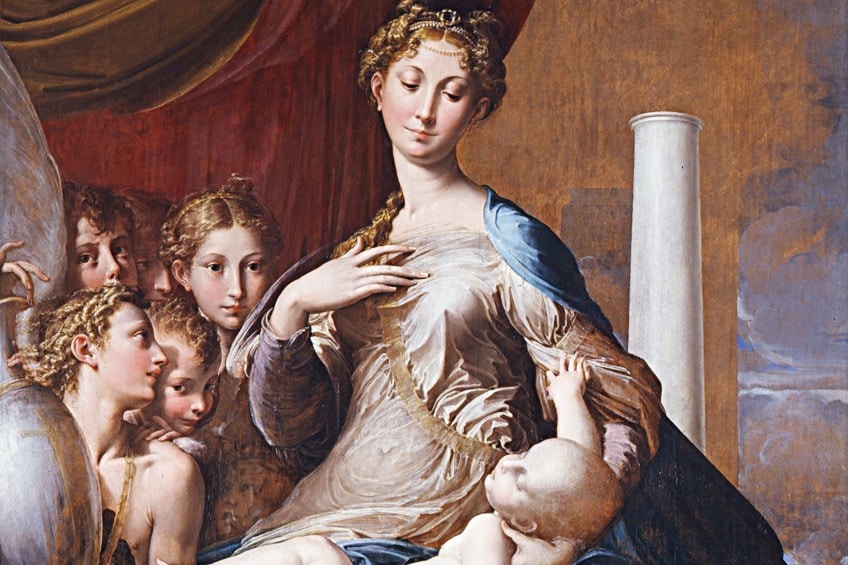 Madonna and Child with Angels, known every bit the "Madonna with the Long Neck" (1534-1540) past Parmigianino; Parmigianino, Public domain, via Wikimedia Commons
Madonna and Child with Angels, known every bit the "Madonna with the Long Neck" (1534-1540) past Parmigianino; Parmigianino, Public domain, via Wikimedia Commons
Some of the out-of-proportion in art examples include the Surrealist work past René Magritte, Personal Values (1952). Hither we run into a room with everyday objects like a rummage, a wine drinking glass, matchstick, shaving cream foaming castor, soap, a bed, a closet, and rugs.
Magritte changes our perspectives of these items past depicting them disproportionately, mostly too large for how we know them to exist.
Another Surrealist artwork includes The Elephants (1948) by Salvador Dalí, which depicts ii elephants with elongated legs that announced wholly out of proportion to their bodies. This painting is believed to symbolize ideas of weight and power, as is feature of elephants, and weightlessness due to their sparse and gangling legs.
Summary of Proportion in Fine art
| Type of proportion in Art | Characteristic | Art Example |
| Standard proportion | Normal or authentic proportion of parts in a visual composition. This will be visually evident when viewing an artwork. | David (1501 – 1504) by Michelangelo |
| Altered proportion | To emphasize an idea or significant, parts of the subject matter will intentionally exist contradistinct in size or shape. | Mother and Child (1921) by Pablo Picasso |
| Hierarchical proportion | To visually betoken the importance of some figures or objects, otherwise, the hierarchy, whether it is familial, social, or in a monarchy, in an art composition. | Nebamun fowling in the marshes (c. 1350) |
| Out of proportion | When the subject area thing of a visual limerick is not in proportional relation to i another. Usually done accidentally or purposefully. | The Elephants (1948) by Salvador Dalí |
Principles of Art – Farther Readings
- Principles of Art primary article
- Movement in Art
- Emphasis in Art
- Unity in Art
- Rhythm in Art
- Texture in Fine art
- Residue in Art
- Harmony in Fine art
In this commodity, we explored that proportion is part of the several principles of art that work alongside the elements of art. Additionally, as one of the principles of art, proportion has different types that can be used every bit techniques for unlike creative purposes. Proportion in fine art has significant versatility and can be applied in numerous ways to make artwork appear either out of this world or proportionally precise. Proportion enables artists to visually portray and convey messages or ideas and emphasize the primary subject matter.
Frequently Asked Questions
What Does Proportion Mean in Art?
Equally ane of the principles of art, proportion refers to how parts of an creative composition, whether it'south a human effigy or a confront, or other objects that make upwardly the subject matter, relate to each other in size, referring to its dimensions.
What Are the Types of Proportion in Art?
There are 4 principal types of proportion in art, namely, standard proportion, which is the accurate or normal proportion between parts; the altered proportion is when the proportion is altered or changed for different reasons; the hierarchical proportion is when the principal figure or object is usually larger than the rest to indicate its hierarchical status, lastly, out of proportion, which refers to figures or object that are visibly not in proportional relation, this is also ordinarily intentional or accidental.
What Is the Divergence Between Calibration and Proportion in Fine art?
The deviation between scale and proportion in fine art is that proportion refers to the relation between parts of a whole, and calibration refers to the size of figures or objects in a composition. These figures or objects could be small or large in scale, but nonetheless be in proportion.
Source: https://artincontext.org/proportion-in-art/
0 Response to "The Size Relationship of Parts to a Whole and to One Another in Art"
Post a Comment